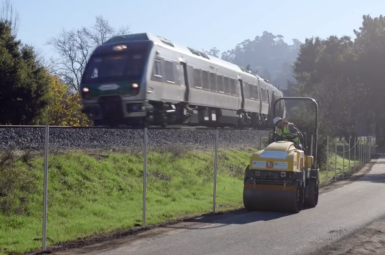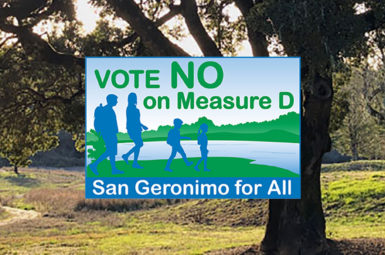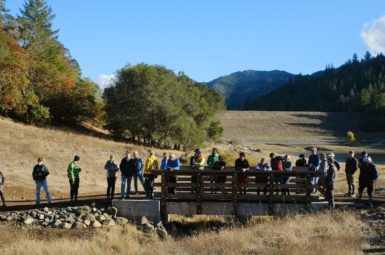March 2020 Election Mill Valley City Council Candidate Questionnaire
As a 501(c)3 nonprofit organization, Marin County Bicycle Coalition cannot endorse candidates for public office, but we are able to share information so that you can arrive at your own conclusion. Below are Mill Valley City Council candidates’ responses to our questionnaire on bicycling in Marin. We have made no content changes. Thanks to the candidates for their time and thoughtful answers!
There are five candidates running for three available seats. We have received responses from all candidates except Sashi McEntee.
Do you ride a bicycle? If so, for what purposes? (transportation/road/mtb)
Urban Carmel: Yes – Transportation, Road, MTB
Kirk Knauer: Yes – Transportation, Road, MTB
Tricia Ossa: Yes – Transportation
Max Perrey: Yes – Transportation, Road, MTB
Do you support the completion of the North-South Greenway, a continuous pathway following the former Northwestern Pacific Railroad alignment (including Alto Tunnel) from Sausalito to Novato? (Yes/no/other)
Urban Carmel: Other (see below)
I am a passionate cyclist. I ride a Gary Fisher Rig singlespeed mountain bike 3-4 times a week up Mt Tam. I am endorsed by both Paul Moe and Tricia Satake of the Mill Valley Bicycle and Pedestrian Advisory Committee. My friend Stephanie Moulton Peters (another endorsement) is running for Supervisor and I have advocated to her that all of Southern Marin, an area only 12 miles long but with a population of 100,000, needs to be integrated with bike ‘highways’ in order to reduce traffic and GHG emissions. I am the Planning Commission Chair and this is how modern cities are now being developed all over the world. I absolutely support a North-South Greenway. Alto Tunnel sounds like the right solution to me but it is highly opposed by vocal neighbors on both sides and so there has been little progress in getting the Greenway completed. If we can get all sides to agree, then I am in full support. If an alternative solution will result in a North-South Greenway earlier, then I would advocate for that and then circle back to Alto Tunnel. I don’t want the tunnel to stop the speedy completion of the Greenway. I am happy to talk to you further about this, but please know that I consider this to be one of the top 3 reasons I am running for City Council.
Kirk Knauer: Yes
Tricia Ossa: Other (see below)
I support the completion of the North-South Greenway BUT the cost to reopen the tunnel is a tremendous amount of money and it would be cost prohibitive. I would like to see the money spent on safer bike lanes over Camino Alto.
Max Perrey: Yes
Would you support the adoption of a Countywide Vision Zero policy and corresponding enforcement, education, and engineering initiatives aimed at eliminating all traffic fatalities and severe injuries? (yes/no/other)
Urban Carmel: Yes
Kirk Knauer: Yes
Tricia Ossa: Yes
Max Perrey: Yes
Please rate the following statements on a scale of 1 (Strongly Disagree) to 5 (Strongly Agree)
Bicycling has the potential to significantly reduce traffic congestion and greenhouse gas emissions from transportation in Marin.
Urban Carmel: 5 – Strongly Agree
Kirk Knauer: 5 – Strongly Agree
Tricia Ossa: 5 – Strongly Agree
Max Perrey: 5 – Strongly Agree
Agencies in Marin should do more to invest in and prioritize active transportation (walking/bicycling).
Urban Carmel: 5 – Strongly Agree
Kirk Knauer: 4 – Agree
Tricia Ossa: 5 – Strongly Agree
Max Perrey: 5 – Strongly Agree
Land managers in Marin should do more to improve trail access for mountain biking.
Urban Carmel: 5 – Strongly Agree
Kirk Knauer: 3 – Do Not Agree or Disagree
Tricia Ossa: 5 – Strongly Agree
Max Perrey: 5 – Strongly Agree
If elected, what would you do to 1) improve safety for people riding bikes in your jurisdiction and 2) increase the number of people who bike?
Urban Carmel: In Mill Valley, we have started to make safe bike routes (Miller Avenue and Camino Alto). In the next 10 years, we will redo E. Blithedale. I have seen plans for putting bike/ped lanes on both sides of Blithedale and removing parked cars for at least a portion of Blithedale. That solution fits the way cities are being planned for the future around the world. That is the first step to improving safety and access for cyclists, and calming traffic on streets like Nelson. Our city completed a traffic study in 2016; in it, a bike/ped flyover crossing 101 and linking Hamilton Dr and Seminary is proposed. This could be an essential component of a bike ‘highway’ linking Southern Marin and will speed the adoption of more cycling as many of our car trips are due to lack of better bike options to get to and from Strawberry and Tiburon. Our City Council can improve its advocacy of cycling’s benefits to traffic reduction and a cleaner environment. For example, all our Council people should ride bikes in the annual Memorial Day parade; we should lead by example. In the 1970s, fully 90% of kids travelled to school via bike or by foot. That should be our goal. In MV, that proportion is now just 50%.
Kirk Knauer: I’m a cyclist, mass transit and ped. resident… and I believe that change starts with me, so I start with me. I commuted 11 years to the city via bicycle and used Sycamore because the other two corridors were much too dangerous. To your question, speaking as council member Kirk, I take my cue championing solutions from neighborhoods, the Bicycle and Pedestrian Advisory Committee (BPAC), our Parks and Recreation Commission, HOAs, neighborhood coalitions, etc. collaborating to continue to make non-car-centric alternatives possible for all Mill Valley residents. The work and stay-at-it attitude that has taken many, many years to make Mill Valley safer for bicyclists and pedestrians (e.g. Miller Avenue as a multi-modal corridor) is part of this council member’s job description. Mobility is changing. We will change. You’ll hear me speak a lot about the death of the internal combustion engine, autonomous taxis/shuttles and the changing landscape of transportation; changes that address the traffic and car-centric legacy that we’ve inherited and espoused for decades. A legacy that is behind us or in the rear-view mirror of many. There are families in Mill Valley who “get it” and are onboard, embracing the concept of “positive change starts with me” and they are happily modifying their habits walking and biking, using our primary multi-modal routes, and promoting changes to make our primary arteries safer – habits and recommendations that don’t just revolve around cars. We, as a city, have made great strides in accommodating change and we must continue that legacy… but at a faster clip. I will be pushing very hard to create a Commission on Sustainability (worst case scenario – I’ll settle for a task force to start) to champion sustainability and quality of life issues in Mill Valley. That commission or task force would (must!) work closely with BPAC, the P&R Commission, the EPC, and city leadership to make recommendations and come up with community-driven solutions respecting our Core Values and enhancing non-car alternatives / opportunities. I pledge to serve on that commission as your council member. Mill Valley is way behind the curve and is moving much too slowly for the progressive California city that it is.
Tricia Ossa: It’s important that we have clear signage for all bike routes. We also need to take measures to improve traffic safety so people who can feel empowered to get out of their cars and onto their bikes. This applies two fold to increasing awareness about and safety around Safe Routes to School. If these routes don’t feel like a safe option for parents they won’t encourage their children to use the route.
Max Perrey: Cycling is an important part of relieving traffic congestion and reducing GHG’s, in addition to being a great form of outdoor recreation. Thus, it is critically important that we improve safety for people riding bikes. In Mill Valley, this involves improving East Blithedale by incorporating safety precautions, adding additional stop signs in the Sycamore Park neighborhood to reduce vehicle speed, and prioritizing Safe Routes to School engineering improvements and education programs. If elected, I would also like to represent Mill Valley on regional transportation boards, and through those positions, seek state and federal funds to take on larger bike safety measures in the southern Marin area and beyond. With added safety measures in place and with the increasing popularity of e-bikes, we have the potential to dramatically increase cycling as a form of transportation. I’d like to also explore a bike share program for Mill Valley, potentially with our neighboring jurisdictions. I look forward to working with the City Council appointed Bicycle Pedestrian Advisory Committee, Marin County Bicycle Coalition, Access4Bikes and our local bike shops to promote cycling in Mill Valley.
What’s your vision for the future of transportation in Marin?
Urban Carmel: In Mill Valley, each household makes an average of 11 car trips per day. The national average is 9 and our roads are built for 6. Over half the kids going to Tam High, Edna, Strawberry and Old Mill are driven or drive themselves. Simply put, we drive too much in Mill Valley. Transportation is the number one cause of GHG emissions in Marin. It is urgent that we significantly reduce the number of car trips and with e-bikes there is no reason 5-10% of each households’ trips can’t be made on bike. This is the future of city planning. Half the new bikes sold in the NL in 2019 were e-bikes. NYC is adding 250 miles of bike lanes. Mill Valley and Marin are actually behind. Our towns are not well linked to encourage bicycling as a viable alternative to car trips. This has to change now. We need safe routes within Mill Valley and between our town and surrounding towns so that commuters can get to ferries in Larkspur, Tiburon and Sausalito safely and quickly. This is one of my top 3 priorities as a Council person.
Kirk Knauer: My work will start at home and my first objective is to help make upcoming changes to our Blithedale corridor so that it becomes a safer, multi-modal transportation artery and to begin to implement traffic-calming and ped/bicycle improvements to the Sycamore and Lomita arteries. To the broader question (vision for Marin), I see Mill Valley as the municipality that pushes the county and the myriad of agencies operating in Marin to adopt new market-driven technologies to move the needle away from single-occupancy vehicle use, and mass transportation solutions.
Tricia Ossa: Marin County has a tremendous opportunity to increase the number of people commuting to work and school using bikes. Mill Valley also has very bikeable neighborhoods. There is a very basic need to encourage people to run errands and grocery shop using their bikes. One of the best ways to do this is by encouraging safe bike lanes on main streets, educating the public about bike safety from a rider’s perspective and a driver’s perspective, and incorporating more places to park bikes when cyclists arrive at their destinations. In Mill Valley, many people use EBikes to get around. It’s becoming an increasingly popular mode of transportation but one huge issue is that many standard bike racks and bike rack placement places don’t accommodate the weight and size of EBikes. As a council member I will champion improvements that make it easier and safer for people to use bikes as their transportation.
Max Perrey: My vision is a Marin transportation network that is free from fossil fuels, and relies on electric bikes, scooters, shuttles, busses, ferries, trains and vehicles in addition to traditional biking and walking for short trips within towns.
What’s your vision for the future of access and recreational opportunities across Marin’s public lands?
Urban Carmel: I am an avid athlete. I have run the Dipsea Invitational 18 years in a row, the Double Dipsea 11 times and I just completed my 5th Quad Dipsea. I ride on Mt Tam 3-4 times per week on a single speed. Southern Marin is the Bend OR and the Boulder CO of the Bay Area. We need to brand ourselves as a community of outdoor enthusiasts and increase access for bicycles on our public lands so that cyclists can travel from the Headlands to West Marin and all points between on trails. Ultra-marathoners like me want to be able to do this as well. This is great for our community and will strengthen our local economies as well, bringing visitors to all our small towns on bike and on foot (and not by car). I started a 501(c) in Mill Valley to support our local public library. We created an endowment of nearly $3m in the past 10 years and have given $650,000 to our library. I have experience creating public-private partnerships to ensure funding for these plans and will use that experience to make improved bike and ped access a reality in Marin. If you have 6 minutes, please listen to an interview I did on why I am running for Council and my priorities, especially increased alternative forms of mobility: https://static.financialsense.com/audio/2020-01/financial-sense-20200114-78b006f.mp3
Kirk Knauer: We moved to Marin because of its commitment and access to recreational opportunities on its public lands. It’s also what keeps us here. My vision starts in my municipality respecting the need for partnerships and consensus-building to bring about positive change to move away from single-occupancy vehicle mentality. I recognize that recreation on our public lands is an extremely important window for all residents and visitors to grasp the importance of protecting and preserving the natural resources of our beautiful county. Recognized as MCBCs Commuter of the Year, I support the mission of MCBC and look forward to working collaboratively with it and its membership.
Tricia Ossa: The citizens of Mill Valley hold the public lands near and dear to their hearts, mountain biking is also a pastime that not only originated in Mill Valley but is beloved by many. Mill Valley does a good job of having designated biking trails on the mountain and throughout public lands. In addition, the current Parks & Recreation Commission is working on finding a place for a pump track on park lands. Recreational opportunities like this exist and I support it when and where it is appropriate.
Max Perrey: I believe that non-motorized forms of recreation including mountain biking, running, hiking, dog walking and horseback riding should be allowed on Marin’s public lands except where it would either A) pose a significant threat to endangered plant or animal species, or B) pose a significant threat to other user’s safety. This approach will provide additional access and recreational opportunities, and will promote a healthy lifestyle. I am proud to be endorsed in this City Council race by Access4Bikes.
candidate websites
Urban Carmel | Kirk Knauer | Sashi McEntee | Tricia Ossa | Max Perrey



